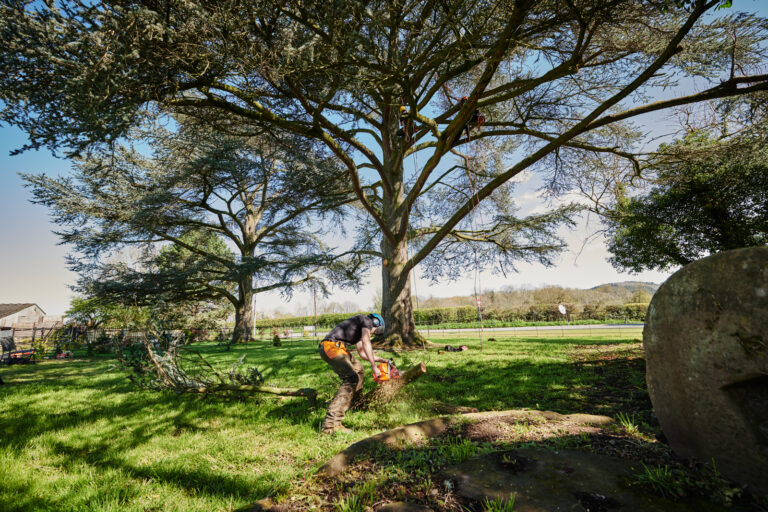Course Content:
This course covers the directional felling of trees using a chainsaw. The felling technique will be appropriate to tree size, weight, condition and species as well as considering guide-bar size and weather conditions. Candidates are required to hold Certificate of Competence in Chainsaw Crosscutting & Maintenance before registration can be done for this course. There will be an assessment day arranged after completion of the course.
Course assessment: The assessment is with an independent assessor and will be made up of both practical assessment and one to one questioning. The recommended duration for this is between 2.5 to 3.5 Hours. It will take place on another day after the course has been completed.
What are the Entry Requirements?
- Age 16+
- Prior to registration for this qualification candidates will need to hold chainsaw maintenance and cross cutting award
- Ideally you should read the course guidance at: https://www.nptc.org.uk/assets/documents/ada7b7cc69d54660add2bbadc5c51ffe.pdf
Course outcomes:
By the end of the course you can expect to be able to do the following:
- Identify the hazards, risks and controls associated with the site, task and machine · State the emergency procedures relevant to the site
- State the appropriate safe working distances from other operators during felling operations
- Describe the safeguards to implement when felling in proximity to a range of different situations
- Describe the legal factors to be considered before felling trees
- State environmental considerations specific to felling
- Describe how to recognise signs of disease and decay in trees and modify felling methods accordingly
- Explain the advantages of setting up or using a natural felling bench, brash mat or similar support prior to felling
- Describe felling techniques for a range of trees and tree sizes up to 380mm and when they would be used
- State what additional equipment, maybe used to assist with the felling of trees
- Describe how to deal with trees that have sat back
- Carry out pre-start checks and setting of the chainsaw
- Prepare trees appropriately to the tree condition and the specification for the site
- Select a felling direction appropriate to tree form and site condition
- Fell trees using recognised felling methods and felling aids
- State incorrect practices for dealing with hung up trees
- Identify where the danger areas are in relation to the trees being taken down
- Describe take down methods for hung up trees
- Describe additional equipment to aid with the take down of a hung-up tree
- State the appropriate actions to take if a tree cannot be taken down
- Take down a hung-up tree using tools
- State the risks to consider when removing branches
- Remove branches from felled trees using a recognised method
- Explain the advantages of leaving a clean stem following branch removal
- State how to deal with brash and branches after branch removal
- State how to measure logs/timber into lengths
- Cross-cut pole length timber in accordance with the site specification
- Stack produce for subsequent operations using appropriate aids and tools
- Check timber is in an appropriate and safe position
- Dispose of waste safely in line with legislation
- Carried out work to minimise environmental damage
- Worked in a way which maintains health and safety and is consistent with relevant legislation and industry good practice
You should:
- You should provide your own personal protective equipment and this must comply with legal requirements, listed below. Personal Protective Equipment (PPE) must be worn at all times. All PPE used must comply with relevant AFAG guidance, industry good practice, Health and Safety Executive publications and current legal requirements in terms of specification and use.
- PPE – Helmet BS EN 397 or EN 12492(also suitable for aerial work), with eye and ear protection
- Outer clothing which is snag proof
- Suitable gloves, may be chainsaw protective
- Chainsaw boots BS EN ISO 1724
- Chainsaw trousers Type A or Type C (all round protection EN381-5, essential for aerial work)
- Personal forestry first aid kit
- Be familiar with the machinery, equipment and tools that they are going to use.
- Be prepared to have a photo, which will be on your qualification card on completion of successful assessment and certification.
The tutor will supply: Necessary equipment & paperwork and documentation for the course
What’s Next? Mandatory qualifications are needed to enter the industry and learners can progress from Level 2 to Level 3.
The following courses are some of the additional courses available: –
- 003922 – City & Guilds Level 2 Certificate of Competence in Tree Climbing and Aerial Rescue
- City & Guilds NPTC Level 3 Award in Felling and Processing Trees Over 380mm
- 003923 – City & Guilds Level 2 Certificate of Competence in Using a Chainsaw from a Rope and Harness










